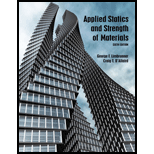
A mass of 320 kg is prevented from falling by a rope wrapped around a horizontal stationary circular pole. A force of 275 N is exerted on the free end of the rope. The coefficient of stat friction between the pole and the rope is 0.25. How many turns of rope around the pole are necessary to keep the weight aloft?
Trending nowThis is a popular solution!
Learn your wayIncludes step-by-step video

Chapter 6 Solutions
Applied Statics and Strength of Materials (6th Edition)
Additional Engineering Textbook Solutions
Automotive Technology: Principles, Diagnosis, And Service (6th Edition) (halderman Automotive Series)
Thinking Like an Engineer: An Active Learning Approach (4th Edition)
Manufacturing Engineering & Technology
Statics and Mechanics of Materials (5th Edition)
Engineering Mechanics: Statics & Dynamics (14th Edition)
- A wedge is used to prop up the 6000-lb block of marble. The wedge angle is =30, and the angle of static friction is s=12 between all contact surfaces. Determine the smallest force P that would prevent the wedge from sliding out.arrow_forwardA 1.1-kg disk A is placed on the inclined surface. The coefficient of static friction between the disk and the surface is 0.35. Is the disk in equilibrium if P=5.5N and =30?arrow_forwardThe figure shows a steel bar being processed by a rolling mill. Given that P=80kN and r =0.016, determine the force F required to advance the bar at a constant speed.arrow_forward
- Draw the FBD of the entire frame, assuming that friction and the weights of the members are negligible. How many unknowns appear on this FBD?arrow_forwardThe coeffient of static friction between the uniform bar AB of weight W and the ground is 0.45. Find the smallest angle and the corresponding force P that would initiate simultaneous tipping and sliding of the bar.arrow_forwardCalculate the horizontal force P required to push the 85-lb lawn mower at constant speed. The center of gravity of the mower is at G, and the coefficients of rolling resistance are 0.12 for the front wheels and 0.18 for the rear wheels.arrow_forward
- The 40-lb spool is suspended from the hanger GA and rests against a vertical wall. The center of gravity of the spool is at G and the weight of the hanger is negligible. The wire wound around the hub of the spool is extracted by pulling its end with the force P. If the coefficient of static friction between the spool and the wall is 0.25, determine the smallest P that will extract the wire.arrow_forwardThe leather rein used to fasten the horse to the hitching rail weighs 3.5 oz per foot. The coefficient of static friction between the rail and the rein is 0.6. If a 34-lb force acting on the bridle is sufficient to restrain the horse, determine the smallest safe length L for the free end of the rein.arrow_forwardThe brake pads at C and D are pressed against the cylinder by the spring BF. The coefficient of static friction between each pad and the cylinder is 0.15. Find the smallest tension in the spring that would prevent the cylinder from rotating when the clockwise couple M=2200lbin. is applied. Neglect the weights of the members.arrow_forward
- The plunger of a door latch is held in place by a spring as shown in Fig. plunger may be ignored. If a force of 2 lb is required to just start closing the door and the coefficient of friction between the plunger and the striker plate is 0.25, determine the force exerted on the plunger by the spring. Friction on the sides of the 2 lb 50°arrow_forwardQ2: - The ladder and the person weigh 30 lb and 180 lb, respectively. The center of mass of the 12-ft ladder is at its midpoint. The angle Assume that the wall is smooth on the ladder. (a) If what is the magnitude of the friction force exerted on the ladder by the floor as shown in fig 2? (b) What minimum coefficient of static friction between the ladder and the floor is necessary for the person to be able to climb to the top of the ladder without slipping? 160 mm 20 ft/s 140 mm 200 40 mm mm 10 | 40 mm 120 mm Fig 1 Fig 2 Fig 3arrow_forwardA heavy cask (full of wine!) sits on an inclined plane. It is held in place by a rope that is attached to the cask and to a hook further up the inclined plane (at A). The rope comes off of the cask tangent to the cask. The mass of the cask is 40 kg, and the coefficient of static friction between the inclined plane and the cask is 0.25. What is the maximum value of 0 just before the cask begins to slip? Also, what is the tension in the rope when slipping is impending? Finally, if the inclined plane became icy, and the rope didn't break as the cask slipped, what would be remarkable about the lines of action of the W, N and T force vectors once equilibrium was re-established? 0.70 m 40arrow_forward
 International Edition---engineering Mechanics: St...Mechanical EngineeringISBN:9781305501607Author:Andrew Pytel And Jaan KiusalaasPublisher:CENGAGE L
International Edition---engineering Mechanics: St...Mechanical EngineeringISBN:9781305501607Author:Andrew Pytel And Jaan KiusalaasPublisher:CENGAGE L
